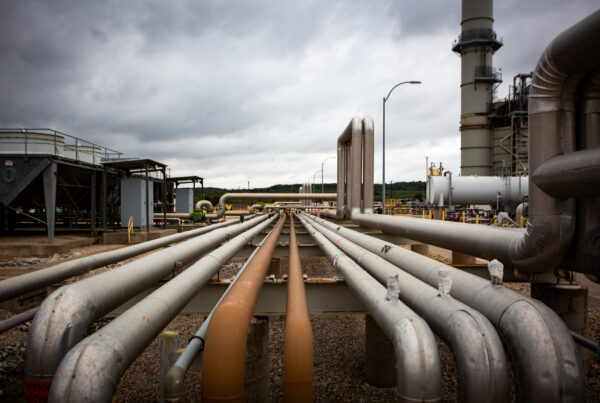Total factor productivity is a wonky metric economists and government officials look at to answer a basic question about the economy: How productive are we? How many resources, workers, and how much money does it cost to produce goods and services?
According to the last available numbers, 12 of the 21 major industries measured by the Bureau of Labor Statistics saw declines in labor productivity in 2022.
To economists, these types of findings are not surprising.
Over the past few decades, researchers have noticed that here in the United States, productivity has gone down. How to solve this issue is the subject of a new working paper co-authored by Andrew Fieldhouse.
He’s a visiting assistant professor of finance at Texas A&M University whose research suggests that the key may be bigger investments in research and development funding. Listen to the interview above or read the transcript below.
This transcript has been edited lightly for clarity:
Texas Standard: We’ve all heard how major government research and development projects have boosted our economy. You know, you think of the advances of the race to the moon that trickle down into computers and consumer electronics. Is that the kind of government investment into R&D we’re talking about here?
Andrew Fieldhouse: Exactly. We’re talking about the National Institutes of Health investing in the Human Genome Project, or the moon mission, with funding by NASA to put a man on the moon. Big mission-oriented projects that have broad knowledge spillovers that benefit the private sector.
So when we talk about productivity, what are we actually talking about and how do you measure it?
Great question. Productivity growth occurs when more economic output goods and services are produced without using more inputs to production, like workers or machinery.
Labor productivity is measured by output per hours worked. So productivity growth means workers are producing more output per hour of labor, and economists interpret productivity growth as reflecting technological progress and greater know how.
It’s what drives long run increases in living standards and GDP. And we find that the changes in appropriations to non-defense agencies that invest in R&D lead to very significant and persistent increases in U.S. productivity growth.
How significant? How big are we talking about here?
The rates of return are very high. 150% to 300%.
Put differently, non-defense government R&D appears to account for about one quarter of U.S. productivity growth since World War II, and the big pullback in government R&D since the late 1960s can account for about a quarter of the slowdown of U.S. productivity growth since then.
That’s pretty remarkable data. But, you know, I was thinking about how companies already get dollar for dollar tax credits for a lot of R&D research, and that represents a major federal investment in its own way. I’m curious about whether or not Uncle Sam’s already putting in a lot viewed through that lens.
Sure. I should clarify that the R&D we’re looking at is government funded R&D, but a lot of it is conducted by the private sector. A lot of it’s conducted by universities like Texas A&M, where I am.
So this isn’t just government R&D conducted in the lab. And we’re looking at appropriations and the dollar funding of actual R&D, not tax incentives for the private sector to do R&D.
But nonetheless, some might hear you talking about this and say, “well, is it sound to pay for more of the work that private companies stand to benefit from?” I mean, why not, say, invest more in massive public infrastructure projects, for example?
That’s a great question. Our paper does actually look at the productivity effects of infrastructure as well.
There’s a large literature suggesting that investing in highways is good for productivity as well. And we need to control for that because the heyday of government R&D back in the 50s and 60s also coincided with big investment in the Eisenhower Highway system. And we find that public infrastructure doesn’t really matter for productivity growth.
The key difference, though, is that the public infrastructure capital stock is about ten times larger than the public R&D capital stock. Historically, we’ve invested way more in infrastructure than in R&D, which means that sort of hit the point of diminishing returns to infrastructure, whereas the returns to R&D are about ten times higher.
Professor, I do think that there is a broad perception that the U.S. does invest a lot when it comes to defense R&D. Are we getting the kinds of returns that one would expect, given what you’re finding in this data?
Great question. We don’t find any evidence of a significant increase in productivity or other measures of innovation in response to R&D for national defense functions.
Now, military knowhow is often classified to maintain military superiority, and that deliberately impedes knowledge spillovers. The Defense Department also invests relatively more in the development of weapons systems and less in basic and applied research. That’s really the focus of the non-defense agencies.
So part of it is the information flow. It’s going to be much more combined in the defense context. You can’t let out a lot of this information that might affect your economy in more broad, robust ways.
Exactly. If everything’s classified, the private sector can’t run with it the same way they can run with basic health research funded by the National Institutes of Health.
Now, this isn’t to say that defense R&D isn’t important, right? Developing more sophisticated weapon systems surely contributes to our national security. But defense R&D does not appear to be driving economic growth the same way as non-defense R&D, at least not within the same time frame.
And so, what then would be your prescription if you were talking to policymakers saying, “look, if we want to do something to turnaround productivity,” what would that be?
Well, the punchline of our paper is that historically, investments in nondefense R&D – particularly those of the National Institutes of Health, the National Science Foundation and the National Aeronautics and Space Administration – have had a huge kick to productivity growth.
Now, as a share of GDP, our investments in R&D today are much, much smaller than they were back in the heyday of the 50s, the 60s and Congress appropriating more money for nondefense R&D looks like it would have an effect of accelerating U.S. productivity growth and leading to a persistent increase in productivity growth, which is what fuels living standard increases.
It would also be something of a silver bullet for our long term fiscal challenges. If you can grow the economy faster with these productivity spillovers, you collect more revenue. And our research shows that government funded R&D seems to be self-financing because of such revenue feedbacks.














